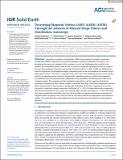Decrypting magnetic fabrics (AMS, AARM, AIRM) through the analysis of mineral shape fabrics and distribution anisotropy
Abstract
Anisotropy of magnetic susceptibility (AMS) and anisotropy of magnetic remanence (AARM and AIRM) are efficient and versatile techniques to indirectly determine rock fabrics. Yet, deciphering the source of a magnetic fabric remains a crucial and challenging step, notably in the presence of ferrimagnetic phases. Here we use X-ray micro-computed tomography to directly compare mineral shape-preferred orientation and spatial distribution fabrics to AMS, AARM and AIRM fabrics from five hypabyssal trachyandesite samples. Magnetite grains in the trachyandesite are euhedral with a mean aspect ratio of 1.44 (0.24 s.d., long/short axis), and > 50% of the magnetite grains occur in clusters, and they are therefore prone to interact magnetically. Amphibole grains are prolate with magnetite in breakdown rims. We identified three components of the petrofabric that influence the AMS of the analyzed samples: the magnetite and the amphibole shape fabrics and the magnetite spatial distribution. Depending on their relative strength, orientation and shape, these three components interfere either constructively or destructively to produce the AMS fabric. If the three components are coaxial, the result is a relatively strongly anisotropic AMS fabric (P’ = 1.079). If shape fabrics and/or magnetite distribution are non-coaxial, the resulting AMS is weakly anisotropic (P’ = 1.012). This study thus reports quantitative petrofabric data that show the effect of magnetite distribution anisotropy on magnetic fabrics in igneous rocks, which has so far only been predicted by experimental and theoretical models. Our results have first-order implications for the interpretation of petrofabrics using magnetic methods.
Citation
Mattsson , T , Petri , B , Almqvist , B , McCarthy , W , Burchardt , S , Palma , J O , Hammer , Ø & Galland , O 2021 , ' Decrypting magnetic fabrics (AMS, AARM, AIRM) through the analysis of mineral shape fabrics and distribution anisotropy ' , Journal of Geophysical Research: Solid Earth , vol. 126 , no. 6 , e2021JB021895 . https://doi.org/10.1029/2021JB021895
Publication
Journal of Geophysical Research: Solid Earth
Status
Peer reviewed
ISSN
2169-9313Type
Journal article
Description
The fieldwork was supported by the DIPS project (grant no. 240467) and the MIMES project (grant no. 244155) funded by the Norwegian Research Council awarded to O.G. O.P.'s position was funded from Y-TEC.Collections
Items in the St Andrews Research Repository are protected by copyright, with all rights reserved, unless otherwise indicated.

